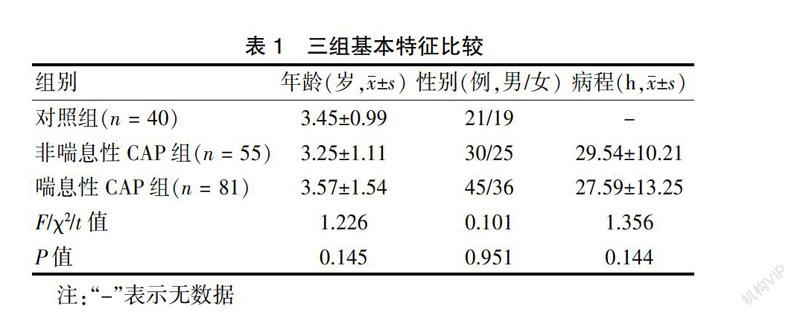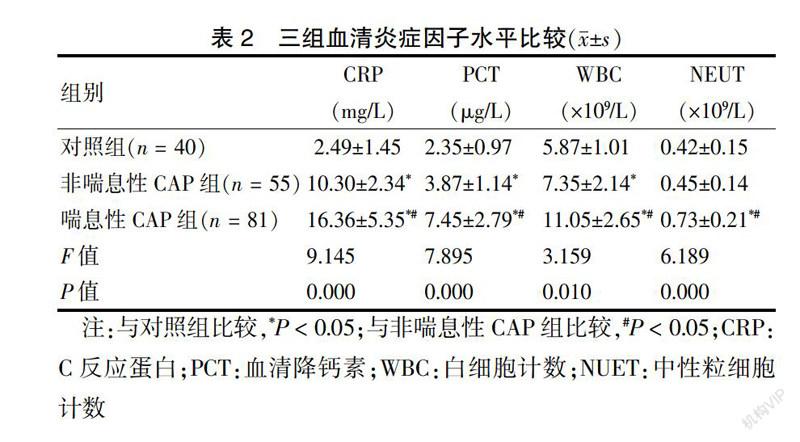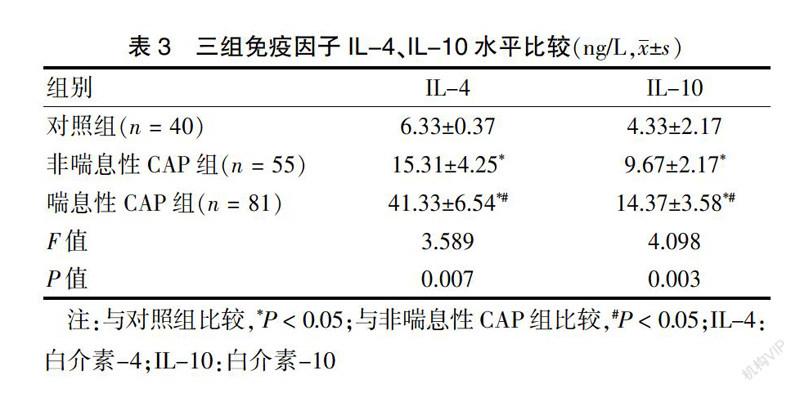血清炎症因子在评估儿童社区获得性
倪金凤 高长俊 郝冬荣 等



[摘要] 目的 探討血清炎症因子C-反应蛋白(CRP)、血清降钙素原(PCT)、白细胞计数(WBC)、中性粒细胞计数(NUET)在预测儿童社区获得性肺炎(CAP)病情时的应用价值。 方法 选取2014年1月~2015年8月在河北省唐山市妇幼保健院进行治疗的CAP患儿136例作为研究对象,包括喘息性CAP组(81例)和非喘息性CAP组(55例),另选取健康儿童40名为对照组。检测并比较CRP、PCT、WBC、NUET及免疫因子白介素4(IL-4)、白介素10(IL-10)的水平,采用受试者工作曲线(ROC)分析血清炎症因子对CAP的诊断价值。 结果 喘息性CAP组的CRP、PCT、WBC、NEUT等指标水平均明显高于对照组及非喘息性CAP组(P < 0.05),非喘息性CAP组的CRP、PCT、WBC水平明显高于对照组(P < 0.05);喘息性CAP组的IL-4、IL-10水平均明显高于对照组及非喘息性CAP组(P < 0.05),非喘息性CAP组的IL-4、IL-10水平明显高于对照组(P < 0.05)。CRP、PCT、WBC、NEUT4中血清炎症因子诊断CAP的ROC曲线下面积分别为0.7749(95%CI:0.7052~0.8446)、0.9589(95%CI:0.9376~0.9802)、0.7528(95%CI:0.6854~0.8203)、0.6311(95%CI:0.5317~0.7205)(P < 0.05),PCT诊断CAP的灵敏度及特异度最高。CRP、PCT、WBC、NEUT4中血清炎症因子诊断喘息性CAP及非喘息性CAP的ROC曲线下面积分别为0.9454(95%CI:0.9080~0.9829)、0.7927(95%CI:0.7182~0.8672)、0.7760(95%CI:0.6967~0.8552)、0.7423(95%CI:0.6599~0.8247)(P < 0.05),CRP诊断喘息性CAP及非喘息性CAP的灵敏度及特异度最高。 结论 CRP及PCT两种指标有利于诊断儿童喘息性及非喘息性CAP。
[关键词] 儿童;社区获得性肺炎;降钙素原;C-反应蛋白;诊断价值
[中图分类号] R563.1 [文献标识码] A [文章编号] 1673-7210(2016)02(a)-0069-04
Clinical value of serum inflammatory cytokines in the assessment of the severity of children with community acquired pneumonia
NI Jinfeng GAO Changjun HAO Dongrong ZHANG Huiyu TIAN Qingling FENG Xue
Department of Paediatrics, Maternal and Child Care Service Center of Tangshan City, Hebei Province, Tangshan 063000, China
[Abstract] Objective To investigate the clinical value of serum inflammatory cytokines such as C-reactive protein (CRP), serum procalcitonin (PCT), white blood cell count (WBC), neutrophil count (NUET) in the assessment of the severity of children with community acquired pneumonia (CAP). Methods One hundred and thirty six children with CAP treated in Maternal and Child Care Service Center of Tangshan City from January 2014 to August 2015 were selected as research objects, including asthmatic CAP group (n = 81) and non-asthmatic CAP group (n = 55), and 40 healthy children were taken as control group. The levels of CRP, PCT, WBC, NUET and immune factors interleukins 4 (IL-4), interleukin 10 (IL-10) were detected and compared. ROC curve analysis was used to analyze the diagnostic value of serum inflammatory factors for CAP. Results The levels of CRP, PCT, WBC, NEUT of asthmatic CAP group were significantly higher than those of control group and non-asthmatic CAP group (P < 0.05), the levels of CRP, PCT, WBC of non-asthmatic CAP group were significantly higher than those of control group (P < 0.05); the levels of IL-4, IL-10 of asthmatic CAP group were significantly higher than those of control group and non-asthmatic CAP group (P < 0.05), the levels of IL-4, IL-10 of non-asthmatic CAP group were significantly higher than those of control group (P < 0.05). The area under the ROC curve of CRP, PCT, WBC, NEUT4 in diagnosis of CAP were 0.7749 (95%CI: 0.7052-0.8446), 0.9589 (95%CI: 0.9376-0.9802), 0.7528 (95%CI: 0.6854-0.8203), 0.6311 (95%CI: 0.5317-0.7205) (P < 0.05), the sensitivity and specificity of PCT in diagnosis of CAP was the highest. The area under the ROC curve of CRP, PCT, WBC, NEUT4 in diagnosis of asthmatic CAP and non-asthmatic CAP were 0.9454 (95%CI: 0.9080-0.9829), 0.7927 (95%CI: 0.7182-0.8672), 0.7760 (95%CI: 0.6967-0.8552), 0.7423 (95%CI: 0.6599-0.8247) (P < 0.05), the sensitivity and specificity of CRP in diagnosis of asthmatic CAP and non-asthmatic CAP was the highest. Conclusion CRP and PCT are good for the diagnosis of asthmatic or non-asthmatic CAP in children.
[Key words] Children; Community-acquired pneumonia; Procalcitonin; C-reactive protein; Diagnostic value
社区获得性肺炎(community acquired pneumonia,CAP)是一种严重威胁人群健康的传统感染性疾病,系指在医院之外的其他场所感染的肺实质炎症。流行病学调查结果显示,CAP患者的病死率为8.8%~15.8%[1-2]。儿童是CAP的重要易感人群,其中儿童因CAP死亡的总人数可占儿童总死亡人数的1/5。病原学研究发现:发达国家与发展中国家CAP的病原微生物有所不同,发达国家主要为病毒感染而发展中国家主要是细菌感染[3-4]。近年来,由于各种抗生素的使用,病原菌的耐药性有增强趋势,为CAP的治疗增加了难度[5-6]。以往的研究结果也显示上述多种血清炎症因子与哮喘的严重程度密切相关[7-8]。临床上,儿童CAP的明确诊断有一定难度,喘息性CAP的诊断更为困难,因此,探索能较为准确地指示儿童CAP病情严重程度的血清炎症因子对儿童CAP的早期诊断和科学治疗均具有重要的临床价值。本研究拟通过检测儿童CAP患者的主要血清炎症因子的水平,重点探讨其对判断和评估患者的病情严重程度的临床价值,旨在为儿童CAP的临床治疗提供参考依据。
1 资料与方法
1.1 一般资料
选取2014年1月~2015年8月在河北省唐山市妇幼保健院(以下简称“我院”)门诊或病房进行治疗的儿童CAP患者136例为研究对象,根据有无哮喘症状,将其分为喘息性CAP组(81例)和非喘息性CAP组(55例)。136例CAP患儿中,男75例,女61例,年龄2个月~8岁。136例CAP患儿的诊断和病情评估均参考《儿童社区获得性肺炎管理指南》[9]的标准。另选取同期在我院查体的健康儿童40名为对照组,对照组均无哮喘、慢性咳嗽病史,体检各方面指标均正常。本研究获得医院医学伦理委员会的批准,同时征得所有患儿及家长同意,并由家长签署知情同意书。
1.2 方法
本研究入选的全部研究对象均抽取静脉血5 mL,分别检测血清C反应蛋白(CRP)、血清降钙素(PCT)、白细胞计数(WBC)、中性粒细胞计数(NUET)、白介素-4(IL-4)、白介素-10(IL-10)等。血清CRP采用乳胶增强免疫比浊法测定,所用仪器为日本日立公司7600-020ISE型自动生化分析仪;血清PCT采用定量固相免疫测定法测定,所用仪器为德国BRAHMS公司;IL-4、IL-10采用酶联免疫吸附测定(ELISA)法测定,所需試剂由生工生物工程(上海)股份有限公司提供;血常规采用日本Sysmex全自动血液分析仪进行测定。
1.3 统计方法
数据处理和统计分析均借助SPSS 20.0进行,计量资料均采用均数±标准差(x±s)的形式表示,采用方差分析进行统计推断(不符合正态分布的采用非参数检验),两两比较采用LSD法进行多重比较;计数资料采用χ2检验进行分析;采用受试者工作曲线(ROC)分析血清炎症因子对CAP的诊断价值,灵敏度=真阳性人数/(真阳性人数+假阴性人数)×100%;特异度=真阴性人数/(真阴性人数+假阳性人数)×100%。以P < 0.05为差异有统计学意义。
2 结果
2.1 三组基本特征比较
三组的性别分布、年龄等比较差异均无统计学意义(P > 0.05),具有可比性,见表1。
表1 三组基本特征比较
注:“-”表示无数据
2.2 三组血清炎症因子水平比较
经方差分析,三组CRP、PCT、WBC、NEUT水平比较差异均有统计学意义(P < 0.05);两两比较结果显示:喘息性CAP组CRP、PCT、WBC、NEUT水平均明显高于对照组及非喘息性CAP组(P < 0.05),非喘息性CAP组CRP、PCT、WBC水平明显高于对照组(P < 0.05)。见表2。
2.3 三组免疫因子IL-4、IL-10水平比较
经方差分析,三组IL-4、IL-10水平比较差异均有统计学意义(P < 0.05);两两比较结果显示:喘息性CAP组IL-4、IL-10水平均明显高于对照组及非喘息性CAP组(P < 0.05),非喘息性CAP组IL-4、IL-10水平明显高于对照组(P < 0.05)。见表3。
表3 三组免疫因子IL-4、IL-10水平比较(ng/L,x±s)
注:与对照组比较,*P < 0.05;与非喘息性CAP组比较,#P < 0.05;IL-4:白介素-4;IL-10:白介素-10
2.4 血清炎症因子判断CAP的ROC曲线
ROC曲线下面积是评价血清因子诊断CAP的重要指标,面积越大,表示其灵敏度及特异度越高。CRP、PCT、WBC、NEUT4中血清炎症因子诊断CAP的ROC曲线下面积差异均有统计学意义(P < 0.05),面积分别为0.7749(95%CI:0.7052~0.8446)、0.9589(95%CI:0.9376~0.9802)、0.7528(95%CI:0.6854~0.8203)、0.6311(95%CI:0.5317~0.7205),从ROC曲线下面积判断,PCT诊断CAP的灵敏度及特异度最高,诊断价值最大。见图1。
2.5 血清炎症因子判断喘息性CAP和非喘息性CAP的ROC曲线
CRP、PCT、WBC、NEUT4中血清炎症因子诊断喘息性CAP及非喘息性CAP的ROC曲线下面积差异均有统计学意义(P < 0.05),面积分别为0.9454(95%CI:0.9080~0.9829)、0.7927(95%CI:0.7182~0.8672)、0.7760(95%CI:0.6967~0.8552)、0.7423(95%CI:0.6599~0.8247),从ROC曲线下面积判断,CRP诊断喘息性CAP及非喘息性CAP的灵敏度及特异度最高。见图2。
3 讨论
儿童发生CAP的原因是多重的,包括患者的年龄、身体素质、营养状况、生活环境等均具有一定的关系[10-12]。CAP对儿童患者的肺部可以产生直接的损害,影响患儿的呼吸功能,其病情程度越严重危害越大,甚至危害患者的生命健康[13]。目前临床上,若要对儿童进行及早的诊断,并较为准确地判断严重程度,则具有一定的难度。儿童哮喘也是一类呼吸道高发病,但对相当比例的婴幼儿来讲,哮喘的症状并不典型,明确诊断特别是早期诊断具有难度。特别是当儿童CAP伴发有哮喘的时候,如何及早明确诊断,是临床上的一个研究热点问题[14-15]。
本研究发现,CAP患者的CRP、PCT、WBC、NUET水平均明显高于健康人,差异有统计学意义(P < 0.05),结果提示,CAP患儿机体由于感染而处于炎症应激状态,机体的免疫防御系统促使血清炎症因子的分泌水平增加,表现为CRP、PCT、WBC及NUET等指标水平升高。同时机体的白介素等免疫指标水平上升,其原因与儿童CAP感染后气道发生异常免疫反应有关,特别是具有哮喘症状的患儿血清炎症因子及白介素水平的升高更甚,因此,CAP可以加重机体的炎症状态,而哮喘则会引起患儿的异常免疫反应加重[15-16]。
CRP的主要功能是评价机体应对炎性刺激或外界伤害的一种急性时相蛋白,可以指示细菌感染、组织损伤的程度。PCT是由甲状腺C细胞分泌的降钙素前体激素。目前已有多项研究表明:机体受到细菌感染时,PCT水平会明显升高[15-17]。而WBC和NUET均是血常规检查的常规血清炎症因子,基本用途也是用于指示机体是否受到了炎症的侵袭。通常情况下,机体发生炎症的时候,CRP、PCT、WBC、NUET等指标均具有一定的升高[13]。但是,此类指标对于指示儿童CAP的临床价值目前尚无定论。本研究通过ROC曲线分析结果表明,CRP、PCT、WBC、NUET等指标用于诊断儿童CAP均具有一定的临床价值,但CRP、WBC诊断儿童CAP缺乏较好的灵敏度,而NUET则特异度较低,诊断价值受到一定限制;而PCT诊断CAP具有较高的灵敏度和特异度,ROC曲线下面积达到最高,因此,PCT诊断儿童CAP的临床价值最高。另一方面,四种血清炎症因子在区别儿童喘息性CAP和非喘息性CAP时也均有一定的价值,但是相比之下,CRP区别喘息性CAP和非喘息性CAP时的灵敏度和特异度是最高的[18-20]。因此,笔者建议在儿童CAP的诊断时或区别喘息性CAP及非喘息性CAP,尽可能地选用CRP及PCT两种指标。
[参考文献]
[1] Wilson KM,Torok MR,Localio R,et al. Hospitalization for community-acquired pneumonia in children:effect of an asthma codiagnosis [J]. Hosp Pediatr,2015,5(8):415-422.
[2] Weinberger M. Community-acquired pneumonia among US children [J]. N Engl J Med,2015,372(22):2167.
[3] Nathan AM,de Bruyne JA. Should all children admitted with community acquired pneumonia have blood cultures taken Authors' reply [J]. Indian J Pediatr,2015,82(7):660-661.
[4] Murphy JF. Community acquired pneumonia(CAP)in children in the new vaccination era [J]. Ir Med J,2015,108(3):68.
[5] 劉翔腾,王桂兰,罗序锋,等.儿童社区获得性肺炎病原微生物分布特点分析[J].中国当代儿科杂志,2013,15(1):42-45.
[6] 马红秋,辛德莉.儿童社区获得性肺炎的病原和治疗[J].实用儿科临床杂志,2009,24(4):318-320.
[7] Tumgor G,Celik U,Alabaz D,et al. Aetiological agents,interleukin-6,interleukin-8 and CRP concentrations in children with community- and hospital-acquired pneumonia [J]. Ann Trop Paediatr,2006,26(4):285-291.
[8] 盛放.儿童社区获得性肺炎流行病学特点及血清降钙素原水平临床分析[J].中华医院感染学杂志,2013,23(6):1400-1402.
[9] 林立,李昌崇.“儿童社区获得性肺炎管理指南(2013修订)”解读[J].中华妇幼临床医学杂志:电子版,2014,15(6):728-732.
[10] Clark JE,Hammal D,Hampton F,et al. Epidemiology of community-acquired pneumonia in children seen in hospital [J]. Epidemiol Infect,2007,135(2):262-269.
[11] Chiang WC,Teoh OH,Chong CY,et al. Epidemiology,clinical characteristics and antimicrobial resistance patterns of community-acquired pneumonia in 1702 hospitalized children in Singapore [J]. Respirology,2007,12(2):254-261.
[12] Chetty K,Thomson AH. Management of community-acquired pneumonia in children [J]. Paediatr Drugs,2007, 9(6):401-411.
[13] 徐勇胜,范永琛.儿童社区获得性肺炎诊治进展[J].中国实用儿科杂志,2011,26(8):637-640.
[14] Haugen J,Chandyo RK,Brokstad KA,et al. Cytokine Concentrations in plasma from children with severe and non-severe community acquired pneumonia [J]. PLoS One,2015,10(9):e0138978.
[15] Esposito S,Garziano M,Rainone V,et al. Immunomodulatory activity of pidotimod administered with standard antibiotic therapy in children hospitalized for community-acquired pneumonia [J]. J Transl Med,2015,13(1):1-10.
[16] Patwari PP,O'Cain P,Goodman DM,et al. Interleukin-1 receptor antagonist intron 2 variable number of tandem repeats polymorphism and respiratory failure in children with community-acquired pneumonia [J]. Pediatr Crit Care Med,2008,9(6):553-559.
[17] Moulin F,Raymond J,Lorrot M,et al. Procalcitonin in children admitted to hospital with community acquired pneumonia [J]. Arch Dis Child,2001,84(4):332-336.
[18] Florin TA,French B,Zorc JJ,et al. Variation in emergency department diagnostic testing and disposition outcomes in pneumonia [J]. Pediatrics,2013,132(2):237-244.
[19] Medical Fees 2015:A comprehensive listing of current UCR and medicare fees with relative value units [M]. Los Angeles,CA:PMIC,2015:644.
[20] Williams DJ,Shah SS,Myers A,et al. Identifying pediatric community-acquired pneumonia hospitalizations:accuracy of administrative billing codes [J]. JAMA Pediatr,2013,167(9):851-858.
(收稿日期:2015-10-27 本文編辑:张瑜杰)

